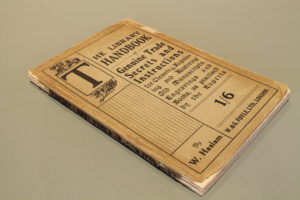
I recently came across this wonderfully titled book and was fascinated, amused and horrified in equal measure. It gives instructions on how “the booklover may spend many a happy hour in renovating or repairing these damaged copies, instead of engaging the services of a skilled bookbinder.” I have highlighted three representative passages from the book which were of particular interest.
“Make a fire of green wood (sappy twigs or fresh cut timber). In the dense smoke of this fire hold your print, so that the smoke stains the paper evenly all over, both back and front, until of the required depth of colour. On removing the engraving you will see that the smoke has dimmed the unnatural gloss and toned the paper in such a way that no one could tell it had ever been bleached.”
“Thumb marks or other unsightly blemishes on the margins, also writing ink on the pages of a book, may be erased by slipping a piece of cardboard under the leaf and rubbing very gently with a small piece of fine glass-paper. Don’t rub a hole in the paper!”
“Restoring Writing on Old Deeds, Etc.– Lay the parchment or paper as flat as possible and damp evenly with clean cold water. Brush over the writing with a flat camel hair brush dipped in a solution of sulphide of ammonia,* when the writing will immediately appear plain and readable.”
The Library Handbook of Genuine Trade Secrets is a thought-provoking document which reminds us how opinions and attitudes have changed since the advent of the professional conservator; moreover, it gives accounts of historic treatments which help to inform a more open modern conservation practice. From experience, it is common that an item being conserved will have been treated in the past, so a good understanding of past techniques, recipes and chemicals used is valuable – I have seen the detrimental effects of all three of the ‘trade secrets’ mentioned above. There are, however, glimpses of a more sensitive and hands-off approach in the book and although little of the advice has stood the test of time, the advice on preserving old manuscripts is pretty similar today.
“Old parchments, whether bound or unbound, should be kept in air-tight and dust-proof cases.”
* Sulphide of ammonia can be fatal if inhaled or swallowed.
Arthur Green, 31st October 2016
